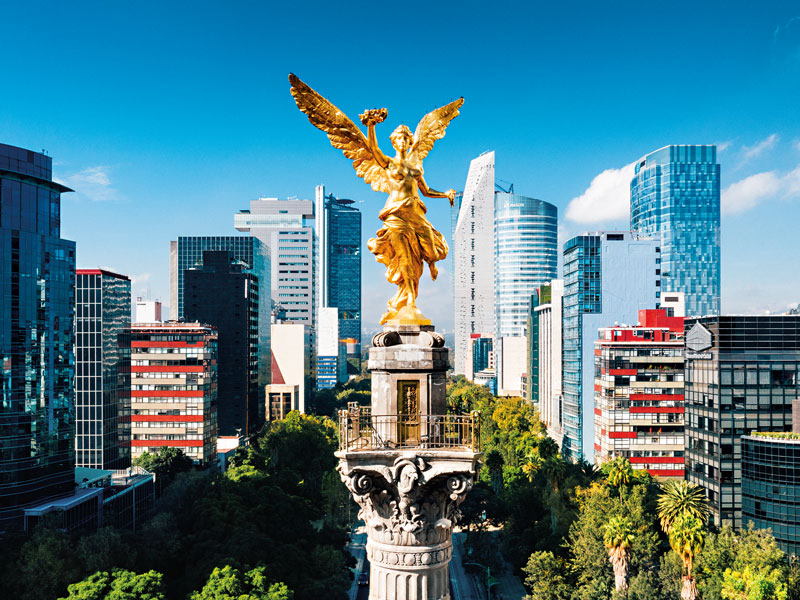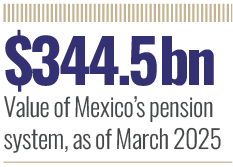
 
Author: David Razú Aznar, Chief Executive Officer, Afore XXI Banorte
The volatility of financial markets has ceased to be a concern exclusive to sophisticated investors. In today’s context of global interdependence, any stock market fluctuation reverberates directly through the lives of millions. One of the most sensitive and least visible links in this chain of volatility is its impact on pension funds. Indeed, the fate of future retirees is increasingly tied to the compass of global markets.
Falls, recoveries and uncertainty
On April 2, a surprise announcement of a broad package of reciprocal tariffs affecting nearly all major trading partners was unveiled in the US. The market reaction was immediate. The S&P 500 fell by 4.8 percent, the Nasdaq plunged by six percent and major European and Asian markets followed the same downward trajectory. Shares of technology giants such as Apple, Nvidia and Tesla recorded losses between five percent and nine percent. These declines reflected investor concerns over the potential for a broad-based trade conflict.
The fate of future retirees is increasingly tied to the compass of global markets
A week later, on April 9, President Trump introduced a tactical adjustment: a 90-day pause on these trade measures and a reduction to 10 percent of the initially announced tariffs, triggering a significant market rebound. However, the truce was only partial: China was excluded and subject to a 125 percent tariff, highlighting a strategy of selective negotiation that introduced both flexibility and uncertainty.
Around the same time, the President’s criticism of Federal Reserve Chair Jerome Powell intensified, particularly over the pace of interest rate adjustments. These public statements had noticeable effects on the markets, at times contributing to volatility. The Fed’s traditionally independent role – long seen as a foundation of US economic stability – faced heightened scrutiny.
Yet, the most consequential episode to date occurred on May 12, when the US and China negotiated a 90-day commercial truce. The agreement dramatically reduced bilateral tariffs and triggered another equity rally. In a single session, the Nasdaq jumped 4.3 percent, and the S&P 500 gained 3.2 percent. The dollar strengthened, the yuan appreciated and global markets rejoiced.
Is this the end of volatility? Hardly. Rather than isolated events, these developments point to the broader uncertainty introduced by a new, more assertive US approach to trade policy – one marked by bold negotiation strategies aimed at achieving more favourable outcomes for the American economy.
Investments with vulnerabilities
In this context, it is important to recall that pension funds allocate a significant portion of their assets to equities, even when regulations limit those investments. In Mexico, pension fund administrators (Afores) have 19.2 percent of their assets invested in equities, of which 70 percent is in foreign markets. For the funds targeting younger workers, that share rises to 23.7 percent.
This means that although pensions are inherently long-term instruments, short-term market shocks can cause considerable impacts. In April, for example, the Afores recorded a monthly effective return of –0.6 percent, equivalent to an annualised –6.9 percent. However, the outlook is not entirely negative. Year-to-date (YTD) returns as of April, even before the rally triggered by the US-China agreement, stood at a positive effective return of 3.7 percent, or nearly 12 percent annualised. In fact, since the inception of the Mexican Afore system in 1997, the real annual return has averaged 4.8 percent (or 10.5 percent in nominal terms), despite various financial crises over the decades: the 1997–98 Asian episode, the 1995–2002 tech bubble, the 2008 real estate global financial crisis driven by subprime mortgages in the US, the 2010–13 European sovereign debt crisis, the 2020 pandemic-induced market collapse, and now, the turbulence caused by President Trump’s trade policies.
Moreover, even in the short term, not all funds experience the same level of exposure. The Target Date Fund, managed by the Afores and designed for workers born after 2000, posted a monthly return of –0.5 percent in April, but a YTD effective return of 4.2 percent, equivalent to an annualised return of over 13 percent. In contrast, the Target Date Fund targeting individuals aged 60 and above was barely affected, recording a –0.05 percent monthly return and a 5.1 percent YTD return, equivalent to over 16 percent annualised. These differences reflect the generational structure of the Mexican system: those closer to retirement are better shielded from volatility through a higher allocation to safer assets, such as government bonds.
The good news is that Mexico’s change in scheme of Target Date Funds has proven itself effective. The bad news is that despite the recent market recoveries, the international context remains complex and uncertain, potentially hindering long-term strategies as trade tensions become structural.
Markets to the global economic model
What is at stake is not merely the health of quarterly earnings or stock performance. It is the very model of economic globalisation that has underpinned global growth for decades. The protectionist policies adopted by the US, while nuanced in their implementation, challenge core principles of free trade.
Pensions rely on sustained economic growth and positive real long-term returns
Even after the truce with China, average US tariffs remain at levels not seen since the 1930s. According to estimates from the Budget Lab at Yale, the average US tariff now stands at 16.4 percent following recent adjustments. Trading partners, including Europe, have responded by hardening their own trade barriers. The result: an international climate of mounting tension and reduced cooperation.
For now, the International Monetary Fund (IMF) has revised down its forecast for global trade growth in 2025 to just 1.7 percent. It is estimated that this year global GDP growth will outpace trade growth, implying that trade as a share of world output will decline. In this environment, global economic growth is at risk. GDP is projected to grow by just 2.8 percent in 2025, down from 3.3 percent in 2024. The US has already reported a real GDP contraction of 0.3 percent in the first quarter. Trade, historically a key engine of expansion, is now being undermined by the closing of economic borders.
The monetary policy dilemma
Moreover, the Federal Reserve has faced pressure from President Trump to lower interest rates. The objective is clear: to support economic growth and bolster stock market performance. However, Jerome Powell has resisted these calls, stressing the importance of carefully monitoring inflation, especially in the face of cost increases driven by tariffs.
This dilemma between orthodox monetary policy and short-term political considerations is becoming more common in advanced democracies. What is at stake is not merely the interest rate level but the institutional autonomy of central banks. This tug-of-war also affects markets, contributing to heightened uncertainty.
Pensions and productivity
Amid this scenario, it is worth returning to basics: pensions rely on sustained economic growth and positive real long-term returns. Achieving this requires more than short-term stock rallies: it requires investment in human, physical and technological capital.
Productivity – not protectionism – is the key to securing dignified retirements. If the world falls into a cycle of diminished cooperation, reduced trade, and heightened uncertainty, the effects will be more lasting than any temporary Nasdaq recovery. At the end of the day, international trade, by expanding markets, promoting specialisation and increasing competition, foster economic growth by creating jobs, also lowering production costs, increasing innovation and technology transfer, and therefore, improving living standards.

There is no doubt that the performance of the stock markets depends on the growth of global consumption and investment in world economic development. And the recent decades showed that the widespread surge of consumption in all regions came hand-in-hand with the expansion of international trade.
Mexico’s pension system has demonstrated resilience, achieving a 32 percent increase in assets over just two years, reaching $344.5bn as of March 2025. This is a good sign, but complacency is not an option. Global economic policy is shaping the structural conditions that will determine the viability of future pensions.
A long-term perspective
Recent market volatility is not accidental. It reflects a deeper transition in the rules of the global economic order. In this context, the Afores and pension funds worldwide face the challenge of navigating uncertainty with a long-term perspective, recognising that institutional stability, international trade, and productive investment remain the cornerstones of any viable retirement system, because they are the foundation of sustained economic growth.
It is the responsibility of long-term actors, such as pension systems, to remain anchored in the long term, because ultimately, this is not just about markets – it is about the people who, after a lifetime of work, expect to retire with dignity.



